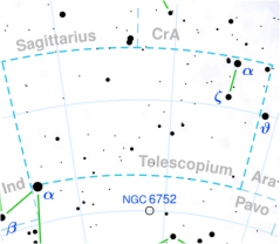Astronomy:Lambda Telescopii
| Observation data Epoch J2000.0 Equinox (celestial coordinates) | |
|---|---|
| Constellation | Telescopium |
| Right ascension | 18h 58m 27.79251s[1] |
| Declination | −52° 56′ 19.1999″[1] |
| Apparent magnitude (V) | 4.84±0.01[2] |
| Characteristics | |
| Spectral type | B9.5 IV/V[3] or B9 III[4] |
| B−V color index | −0.05[5] |
| Astrometry | |
| Radial velocity (Rv) | −2±4.2[6] km/s |
| Proper motion (μ) | RA: +13.365[1] mas/yr Dec.: −8.805[1] mas/yr |
| Parallax (π) | 6.6117 ± 0.1718[1] mas |
| Distance | 490 ± 10 ly (151 ± 4 pc) |
| Absolute magnitude (MV) | −1.51[7] |
| Details | |
| Mass | 2.81+0.36−0.38[8] M☉ |
| Radius | 5.53±0.28[9] R☉ |
| Luminosity | 260+13−12[1] L☉ |
| Surface gravity (log g) | 3.56[10] cgs |
| Temperature | 10,139[11] K |
| Metallicity [Fe/H] | +0.19[11] dex |
| Rotational velocity (v sin i) | 110[12][13] km/s |
| Age | 268[14] Myr |
| Other designations | |
| Database references | |
| SIMBAD | data |
λ Telescopii, Latinized as Lambda Telescopii, is a solitary,[16] bluish-white hued star located in the southern constellation of Telescopium. It has an apparent magnitude of 4.84,[2] making it readily visible to the naked eye under ideal conditions. Gaia DR3 parallax measurements imply a distance of 490 light years,[1] and it is currently approaching the Solar System with a somewhat constrained heliocentric radial velocity of −2 km/s.[6] At its current distance, the visual magnitude of Lambda Telescopii is diminished by an extinction of 0.25 due to interstellar dust[17] and it has an absolute magnitude of −1.51.[7]
The object has been given several stellar classifications over the years. Lambda Telescopii has been classified as B9 III (evolved giant star),[4] A0 V (A-type main-sequence star),[13] and B9 .5 IV/V.[3]
The accepted classification for Lambda Telescopii is B9.5 IV/V,[3] indicating that it is a late B-type star with the blended luminosity class of a subgiant and a main sequence star. Gaia DR3 stellar evolution models place it near the end of its main sequence lifetime.[1] The star is 268 million years old[14] with a relatively high rate of spin, showing a projected rotational velocity of 110 km/s.[12][13] Lambda Telescopii is metal enriched with an iron abundance 155% that of the Sun, or [Fe/H] = +0.19.[11] The star has 2.81 times the mass of the Sun[8] and it radiates 260 times the luminosity of the Sun[1] from its photosphere – which is 5.53 times the size of the Sun's – at an effective temperature of 10,193 K.[9] [11]
References
- ↑ 1.0 1.1 1.2 1.3 1.4 1.5 1.6 1.7 Vallenari, A. et al. (2022). "Gaia Data Release 3. Summary of the content and survey properties". Astronomy & Astrophysics. doi:10.1051/0004-6361/202243940 Gaia DR3 record for this source at VizieR.
- ↑ 2.0 2.1 Høg, E.; Fabricius, C.; Makarov, V. V.; Urban, S.; Corbin, T.; Wycoff, G.; Bastian, U.; Schwekendiek, P. et al. (March 2000). "The Tycho-2 catalogue of the 2.5 million brightest stars". Astronomy and Astrophysics 355: L27–L30. ISSN 0004-6361. Bibcode: 2000A&A...355L..27H.
- ↑ 3.0 3.1 3.2 Houk, N.; Cowley, A. P. (1975). University of Michigan Catalogue of two-dimensional spectral types for the HD stars: Declinations −90° to −53°. 1. Bibcode: 1975mcts.book.....H.
- ↑ 4.0 4.1 de Vaucouleurs, A. (1 August 1957). "Spectral Types and Luminosities of B, A and F Southern Stars". Monthly Notices of the Royal Astronomical Society 117 (4): 449–462. doi:10.1093/mnras/117.4.449. ISSN 0035-8711. Bibcode: 1957MNRAS.117..449D.
- ↑ Corben, P. M.; Stoy, R. H. (1968), "Photoelectric Magnitudes and Colours for Bright Southern Stars", Monthly Notes of the Astronomical Society of Southern Africa 27: 11, Bibcode: 1968MNSSA..27...11C.
- ↑ 6.0 6.1 Gontcharov, G. A. (November 2006). "Pulkovo Compilation of Radial Velocities for 35,495 Hipparcos stars in a common system". Astronomy Letters 32 (11): 759–771. doi:10.1134/S1063773706110065. ISSN 1063-7737. Bibcode: 2006AstL...32..759G.
- ↑ 7.0 7.1 Anderson, E.; Francis, Ch. (May 2012). "XHIP: An extended hipparcos compilation". Astronomy Letters 38 (5): 331–346. doi:10.1134/S1063773712050015. ISSN 1063-7737. Bibcode: 2012AstL...38..331A.
- ↑ 8.0 8.1 Stassun, Keivan G. et al. (9 September 2019). "The Revised TESS Input Catalog and Candidate Target List". The Astronomical Journal 158 (4): 138. doi:10.3847/1538-3881/ab3467. Bibcode: 2019AJ....158..138S.
- ↑ 9.0 9.1 Kervella, P.; Thévenin, F.; Di Folco, E.; Ségransan, D. (October 2004). "The angular sizes of dwarf stars and subgiants. Surface brightness relations calibrated by interferometry". Astronomy & Astrophysics 426 (1): 297–307. doi:10.1051/0004-6361:20035930. ISSN 0004-6361. Bibcode: 2004A&A...426..297K.
- ↑ Anders, F. et al. (August 2019). "Photo-astrometric distances, extinctions, and astrophysical parameters for Gaia DR2 stars brighter than G = 18". Astronomy & Astrophysics 628: A94. doi:10.1051/0004-6361/201935765. ISSN 0004-6361. Bibcode: 2019A&A...628A..94A.
- ↑ 11.0 11.1 11.2 11.3 Erspamer, D.; North, P. (28 January 2003). "Automated spectroscopic abundances of A and F-type stars using echelle spectrographs". Astronomy & Astrophysics 398 (3): 1121–1135. doi:10.1051/0004-6361:20021711. ISSN 0004-6361. Bibcode: 2003A&A...398.1121E.
- ↑ 12.0 12.1 Huang, Su-Shu (September 1953). "A Statistical Study of the Rotation of the Stars.". The Astrophysical Journal 118: 285. doi:10.1086/145751. ISSN 0004-637X. Bibcode: 1953ApJ...118..285H.
- ↑ 13.0 13.1 13.2 Levato, O. H. (August 1972). "Rotational Velocities and Spectral Types of Some A-Type Stars". Publications of the Astronomical Society of the Pacific 84: 584. doi:10.1086/129336. ISSN 0004-6280. Bibcode: 1972PASP...84..584L.
- ↑ 14.0 14.1 Gontcharov, G. A. (November 2012). "Spatial distribution and kinematics of OB stars". Astronomy Letters 38 (11): 694–706. doi:10.1134/S1063773712110035. ISSN 1063-7737. Bibcode: 2012AstL...38..694G.
- ↑ "lam Tel". SIMBAD. Centre de données astronomiques de Strasbourg. http://simbad.u-strasbg.fr/simbad/sim-basic?Ident=lam+Tel.
- ↑ Eggleton, P. P.; Tokovinin, A. A. (11 September 2008). "A catalogue of multiplicity among bright stellar systems". Monthly Notices of the Royal Astronomical Society 389 (2): 869–879. doi:10.1111/j.1365-2966.2008.13596.x. ISSN 0035-8711. Bibcode: 2008MNRAS.389..869E.
- ↑ Gontcharov, George A.; Mosenkov, Aleksandr V. (28 September 2017). "Verifying reddening and extinction for Gaia DR1 TGAS main sequence stars". Monthly Notices of the Royal Astronomical Society 472 (4): 3805–3820. doi:10.1093/mnras/stx2219. ISSN 0035-8711. Bibcode: 2017MNRAS.472.3805G.
<ref> tag with name "Gould1879" defined in <references> is not used in prior text.
 |


